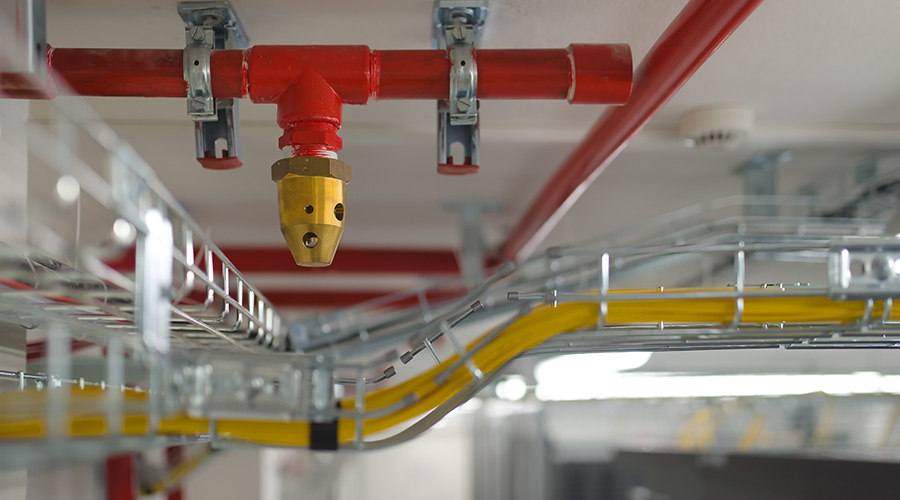Understanding Today’s Advanced Fire Detection Options
Part 2 of a two-part article about improvements in fire detection technology
Improvements in technology have led to today's more advanced fire detection options.
Since the development of intelligent smoke detectors, manufacturers have been factoring in the building’s environment and what causes the false alarms, which led to the development of multi-sensor devices. Multi-sensor detection utilizes dual criteria to initiate an alarm condition. A dual-criteria sensor includes photoelectric and thermal elements within the same detector. It can adapt to the changes in the environment, automatically adjusting the alarm thresholds. A dual-sensor detector continually looks for evidence of smoke and heat; if it senses smoke without heat, it will continue to check for a heat component. However, if smoke continues without heat, it will send an alarm to the fire panel. If the device senses smoke and heat, it automatically sends a signal to the fire alarm panel because it is considered a verified response.
The next advance brought quad criteria detector, a unique detector with the ability to detect all four major elements of a fire. This advanced sensor monitors for carbon monoxide, infrared, photoelectric, and thermal properties of combustion and has proven to reduce false alarms.
Although the above smoke detection technology has improved the ability to determine the early stages of fire and reduce false alarms, the detection method that truly seems poised for the future is the Air Sampling Detector (ASD). ASD is a proactive technology drawing air to the sensor instead of waiting for the smoke to arrive at the detector through air circulation or until the room fills with smoke and eventually reaches the ceiling mounted smoke detector. Air sampling filters dirt and dust to test for smoke or any by-product of combustion, providing the earliest possible warning and reducing false alarms. The ASD consists of a network of piping with sampling holes replacing spot smoke detectors. Due to its design, ASD allows for placement where conventional detection cannot be used, such as historical buildings where a spot detector would disrupt the aesthetics of the building. It is also widely used in harsh environments such as zoo cages or in areas that are difficult for inspections, testing, and maintenance, such as buildings with high ceilings or large atriums. Since ASD can detect the earliest stages of a fire event initiating a pre-alarm condition allowing personnel time to investigate the situation before escalation.
Although the advances in smoke detection technology are available today, they are not commonly used due to both the “low bid” process and lack of specific code requirements. Most buildings are built, or fire alarms are installed under the premise “low bid” gets the job. Low bid doesn’t always mean “low bid,” dollar amount. What “low bid” reflects is that the bidder chose to bid the plans and specifications or design their proposal based on the code minimum — i.e., lowest requirements. Not that it’s wrong, or that the designer was negligent during the design process, but, with the litigious society we live in today, low bid should not be the determining factor. With the detection technology readily available and the importance of saving property and lives, we should hold ourselves to higher standards.
Regardless of low bid design or code requirements, even with the best design with the latest technology, you can’t always remove false alarms without proper inspection, testing, and maintenance. This requirement falls on the building owner and like everything else, it comes down to cost. Even with the significant advances in smoke detection technology, annual inspections, testing, and maintenance are the only way to ensure the system is working properly and is reliable when smoke and fire comes its way. Code requires annual inspections, but Authorities Having Jurisdiction (AHJs) typically don’t have the time or resources to inspect every building each year. Insurance companies also require inspections but only come out during a renewal or if you’re changing insurance companies. The building owners are responsible for ensuring their fire and life safety systems are working and too many times budget cuts or negligence result in loss of life and property.
The fact is more people die from smoke than the actual fire, and no detection technology is perfect. The advancements in smoke detection have evolved to mitigate the loss of life and property as well as provide detection in unique environments. Although advanced methods of detections are not required by code, or represented in a low bid, these methods alleviate the issues caused by false alarms and detect fire faster for extra escape time where lightweight construction is used.
Chris Wilhelm is executive director of construction for Tech Electronics. His duties include overseeing all construction projects in the St. Louis area as well as directing construction strategy and marketing at the company’s six regional offices. He is also responsible for overseeing all fire alarm projects, including managing relationships with fire alarm system manufacturers.
Related Topics:













